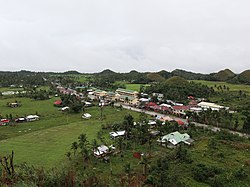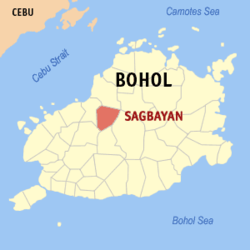Sagbayan Borja | |
|---|---|
| Municipality of Sagbayan | |
 San Agustin | |
 Map of Bohol with Sagbayan highlighted | |
 Interactive map of Sagbayan | |
Location within the Philippines | |
| Coordinates: 9°55′N124°06′E / 9.92°N 124.1°E | |
| Country | Philippines |
| Region | Central Visayas |
| Province | Bohol |
| District | 2nd district |
| Founded | February 9, 1949 |
| Renamed | June 21, 1957 |
| Barangays | 24 (see Barangays) |
| Government | |
| • Type | Sangguniang Bayan |
| • Mayor | Restituto Q. Suarez III (suspended) [2] Asuncion B. Ybañez (acting) |
| • Vice Mayor | RR Fajardo |
| • Representative | Ma. Vanessa C. Aumentado |
| • Municipal Council | Members |
| • Electorate | 17,494 voters (2025) |
| Area | |
• Total | 69.61 km2 (26.88 sq mi) |
| Elevation | 424 m (1,391 ft) |
| Highest elevation | 327 m (1,073 ft) |
| Lowest elevation | 47 m (154 ft) |
| Population (2024 census) [4] | |
• Total | 25,329 |
| • Density | 363.9/km2 (942.4/sq mi) |
| • Households | 5,897 |
| Economy | |
| • Income class | 4th municipal income class |
| • Poverty incidence | 25.05 |
| • Revenue | ₱ 160.4 million (2022) |
| • Assets | ₱ 387.9 million (2022) |
| • Expenditure | ₱ 157.4 million (2022) |
| • Liabilities | ₱ 57.88 million (2022) |
| Service provider | |
| • Electricity | Bohol 1 Electric Cooperative (BOHECO 1) |
| Time zone | UTC+8 (PST) |
| ZIP code | 6331 |
| PSGC | |
| IDD : area code | +63 (0)38 |
| Native languages | Boholano dialect Cebuano Tagalog |
Sagbayan, officially the Municipality of Sagbayan (Cebuano : Munisipyo sa Sagbayan; Tagalog : Bayan ng Sagbayan), is a municipality in the province of Bohol, Philippines. According to the 2020 census, it has a population of 24,335 people. [6]
Contents
- Etymology
- History
- Geography
- Barangays
- Climate
- Demographics
- Economy
- Gallery
- See also
- References
- External links
Its main attraction is Sagbayan Peak, a tourism site overlooking a scenic valley with an observation platform and children's playground. [7] While some similar hill formations are visible, it is not within the main Chocolate Hills area.
Sagbayan is 74 kilometres (46 mi) from Tagbilaran.
Sagbayan celebrates its feast on May 4/August 28, to honor the town patron San Agustin. [8]




